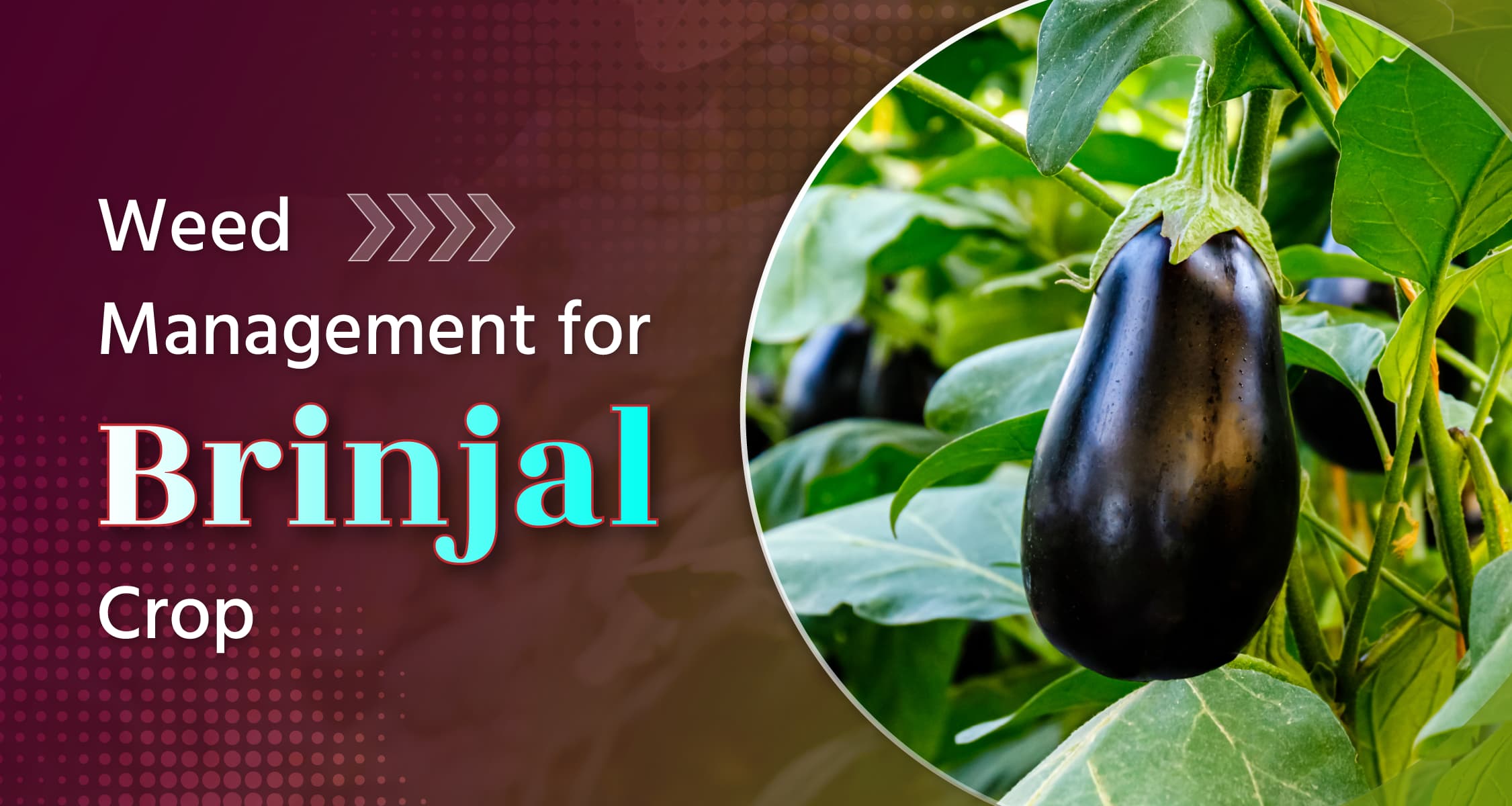Weed Management in Brinjal

Weed Management in Brinjal
Weeds can have a detrimental impact on the yield and quality of brinjal crops. They absorb essential nutrients from the soil, leading to a potential reduction in crop yield by up to 50%. Correct identification of weeds is crucial, and agricultural experts can provide guidance if issues arise in the field. Fortunately, there are numerous agricultural tools and inputs available in the market that can effectively address weed problems, offering solutions to mitigate their impact on crop production. Through this post, we will be going through important information about the damage caused by weeds, various methods of controlling them, and vital things to consider while using weedicide/herbicide.
Damages Caused by Weeds in Brinjal Crops
- Less Availability of Nutrients: Weeds growing in the field absorb nutrients from the soil, due to which the brinjal plants do not get the right amount of nutrition.
- Reduction in Flowers and Fruits: Excess weeds can reduce the number of flowers and fruits in brinjal plants.
- Size of Fruits: Weeds can affect the growth of fruits adversely. This leads to the reduction of the size of fruits in brinjal crops.
- Diseases and Pests: Many types of pests and fungi initially grow on weeds and later attack the primary crop. This adversely affects the crops leading to a reduction in yield and quality.
- Decrease in Crop Yield: Weeds cause substantial damage to primary crops that lead to a reduction in the yield of crops. Therefore, farmers have to face losses by selling the reduced and low-quality yield.
- Increase in Costs: Using herbicides/weedicides increases the input costs of agriculture. Along with this, farmers also use various pesticides and other chemicals to control pests and diseases, which also adds up to the initial cost.
- Shortage of Supply: As weeds affect the crop adversely, there may arise the chances of a potential shortage of brinjal in the market. This situation could lead to farmers suffering losses instead of profits. Furthermore, the shortage in supply can lead to an increase in the price of brinjal.
Weed Control Methods
Through Weeding
- Weeding is a major technique that can be helpful in controlling weeds.
- After 20 to 25 days of sowing, the first weeding can be done.
- Subsequently, this process can be repeated as per requirement.
- Weeding ensures that the crop is well nourished and helps in reducing weeds.
Through Mulching
- Mulching is an advanced method to control weeds in the field.
- Covering the land of plants in the field properly from all sides with plastic cover, straws or leaves, etc. is called mulching.
- Mulching restricts the germination or growth of weeds. With this technique, crops can be protected from weeds for a longer period.
Through Weedicides/Herbicides
- The use of chemicals against weeds is also another way of controlling weeds.
- For this, before transplanting the plants, use 250 gm of Pendimethalin 38.7% CS (Dhanuka- Dhanutop Super, UPL- Dost Super, BASF- Stomp Xtra) per acre of land.
- For broad leaf weeds, 1 week before transplantation or 15 days after transplantation, use 200 gm Metribuzin 70% WP (Dhanuka- Barrier, Bayer- Sencor, Indorama- Shaktiman Metriman, Shivalik Crop Science- Sacon) per acre of field.
Factors to Consider While Applying Herbicides/Weedicides
- It is very important to consider some vital factors while applying herbicides/weedicides.
- While using weedicides/herbicides, moisture content should be present in the soil, so that the chemicals can reach the crop properly.
- Weedicides/herbicides should be sprayed in the morning or evening.
- While spraying, herbicide/weedicide should be sprayed in the correct quantity. It prevents any kind of adverse effects on the crop.
- Any kind of insecticides, pesticides, or fungicides should not be mixed with herbicides. This may reduce the effect of herbicides.
What methods do you use to control weeds in brinjal crops? Share your answers with us in the comments. If you find the information provided in this post useful, don't forget to like and share it. For more information on weed control, follow the 'Weed Management' channel now. Also, to get proper advice on weed management from agri-experts, you can contact DeHaat's toll-free number - 1800-1036-110.
Frequently Asked Questions (FAQs)
Q: How is weeding done?
A: Weeding is done to control the weeds growing in the field. A spade, hoe, or harrow is used for weeding. In this process, weeds are removed by uprooting them or cutting them near the upper surface of the soil. This process requires more time and labor. Therefore, this method is used more in small fields.
Q: What are the different methods for weed control?
A: There are many methods to control weeds in agriculture. The most common methods include traditional, tool-based, and chemical-based like weedicides/herbicides, and other biological methods. Traditional control involves crop rotation, intercropping, and mulching to prevent weed growth. Under tool-based control methods, weeds are removed by hand and mowing. In chemical-based control methods, herbicides/weedicides are used to kill weeds. Apart from this, weeds can also be controlled by using organic inputs.
Q: How to prevent weeds in fields?
A: To prevent weeds from growing in the field, carry out deep plowing before planting the crop. This will eliminate the weeds already present in the field. Use high-quality seeds for sowing. Clean the seeds thoroughly before sowing. Make sure that there are no weed seeds along with the crop seeds. Mulching in the fields also helps mitigate this problem. Apart from this, we can also control this problem by using chemical weedicide/herbicide within 2 days after sowing.
जारी रखने के लिए कृपया लॉगिन करें

फसल चिकित्सक से मुफ़्त सलाह पाएँ
